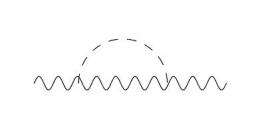January 28, 2010 feature
Physicists Investigate Possibility of an 'Unhiggs'

(PhysOrg.com) -- One of the biggest goals of the LHC is to discover the Higgs boson, the only particle in the Standard Model that has not yet been observed. In general, physicists are pretty confident that the Higgs does in fact exist, although they have spent a lot of effort searching for the particle in less powerful accelerators without success. While patiently waiting for the LHC to reach its full energy and a Higgs particle to leave a signature in a detector, some physicists are investigating alternative scenarios. One of the most recent proposals is that the Higgs is not a particle, but an unparticle called the Unhiggs.
The Unhiggs idea was first suggested in a paper published in November 2009 by physicists David Stancato and John Terning of the University of California, Davis. The Unhiggs is not all that different from the Higgs, except that it demonstrates unparticle behavior and, subsequently, does not fit in with the Standard Model. While a particle has discrete parameters, the Unhiggs’ parameters are continuous. In this sense, the Unhiggs is itself a continuum, and can be thought of as a collection of many Higgs bosons, each carrying a fraction of the Unhigg’s total value.
“In particle physics, we are used to dealing with (surprise) particles,” Adam Falkowski, a physicist at Rutgers University, told PhysOrg.com. Falkowski and Manuel Pérez-Victoria of the University of Granada are also investigating the possibility of the Unhiggs. “One property of particles is a well defined mass. For an unstable particle (such as the Higgs boson in the Standard Model), we can experimentally determine the mass by measuring the momenta of its decay products and computing the so-called invariant mass. Particles show as bumps, or resonances, in the invariant mass spectrum or other kinematical distributions.
“Unparticles, on the other hand, do not have a well defined mass; in fact, an unparticle can be thought of as a superposition of an infinite number of particles with different masses. For this reason, unparticles don’t show up as resonances. Instead, they show up as subtle modifications of kinematical distributions measured by experiment, and therefore they can be difficult to spot.”
In their study, Stancato and Terning showed that the possibility of an Unhiggs is theoretically consistent (which was not obvious a priori). The physicists found that the Unhiggs can do many things that the Higgs does. For example, both the particle and the continuum possess a non-zero vacuum expectation value, which can “break electroweak symmetry” and “unitarize WW scattering” - abilities that are important for giving other particles mass, which is a fundamental role of the Higgs. In addition, the scientists found that the Unhiggs can do something that the Higgs cannot: provide a solution to the so-called little hierarchy problem.
More recently, Falkowski and Pérez-Victoria have further investigated the properties of the Unhiggs. In their study, they have explored certain experimental predictions of the Unhiggs proposal, such as how the Unhiggs affects precision observables measured by experiment. The scientists found that the Unhiggs is even more like the Higgs than previously thought, in that it closely mimics the Higgs for some light masses. They also found that the primary difference between the Unhiggs and the Higgs is due to their different propagators: while the Higgs’ propagator is mathematically described as a pole, the Unhiggs’ propagator is a branch. This characteristic is what makes the Unhiggs difficult to detect in collider experiments.
“Propagators are mathematical functions that are used for computing amplitudes in quantum theories,” Falkowski explained. “Amplitudes determine the probability of certain events to occur in our colliders. The ‘pole’ means that the propagator becomes very large for certain values of the momenta corresponding to the particle mass; mathematically, this is the origin of resonances in kinematical distributions measured by experiment. Propagators for unparticles do not have poles, but rather branch cuts (discontinuities of the imaginary part), and therefore unparticles do not show up as resonances.”
Instead, when the Unhiggs “decays,” it becomes suppressed, making its decay product mostly invisible. Still, the physicists say that a more detailed analysis of the collider’s constraints is necessary in order to determine if the Unhiggs might be observed. If physicists do find a way to determine its existence, the Unhiggs could possibly reveal information about the elusiveness of new physics beyond the Standard Model. Falkowski and Pérez-Victoria are currently working on a theoretical framework where not only the Higgs but also the W and Z bosons have unparticle components.
“At the present stage it's hard to say whether the idea is useful, that is to say whether it solves any problems that are troubling particle physicists,” Falkowski said. “Our approach in the paper was rather that the Unhiggs could be the reality, and explore consequences of that assumption. As I said, a priori it was far from obvious that the Unhiggs is theoretically consistent, or if it's consistent with all experimental results up to date. The usefulness of this direction of research is that it allows the experimental physicists to prepare their experiments such that the Unhiggs, if present, would not be missed.”
More information: Adam Falkowski and Manuel Pérez-Victoria. “Electroweak precision observables and the unhiggs.” Journal of High Energy Physics. Doi:10.1088/1126-6708/2009/12/061. http://arxiv.org/abs/0901.3777
David Stancato and John Terning. ”The Unhiggs.” Journal of High Energy Physics. Doi:10.1088/1126-6708/2009/11/101. http://arxiv.org/abs/0807.3961
Copyright 2010 PhysOrg.com.
All rights reserved. This material may not be published, broadcast, rewritten or redistributed in whole or part without the express written permission of PhysOrg.com.



















